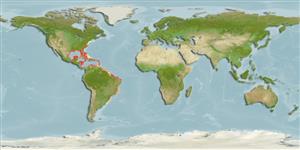Environment: milieu / climate zone / depth range / distribution range
ນິເວດວິທະຍາ
ສັດທະເລ ກ່ຽວກັນຫີນ; ລະດັບຄວາມເລິກ 2 - 50 m (Ref. 9710). Subtropical; 45°N - 34°S, 98°W - 34°W
Western Atlantic: Canada (Ref. 5951), Massachusetts (USA) to Brazil, including Bermuda, the Gulf of Mexico and the Caribbean. Mediterranean Sea (Ref. 50345).
ຂະໜາດ / ນ້ຳໜັກ / Age
Maturity: Lm ? range ? - ? cm
Max length : 55.0 cm TL ຕົວຜູ້/ບໍ່ມີເພດ; (Ref. 40637); common length : 30.0 cm TL ຕົວຜູ້/ບໍ່ມີເພດ; (Ref. 5217); ນ້ຳໜັກສູງສຸດທີ່ເຄຍຈັດພີມມາ: 3.3 kg (Ref. 40637)
With small diffuse white spots; two areas where the hexagonal plates are dark-edged, forming chain-like markings, one on the pectoral region of the body and the other half way between gill opening and posterior end of carapace; large individuals lose the pale spots and chain markings and develop an irregular dark reticulate pattern over the entire carapace and caudal peduncle (Ref. 13442).
Inhabits seagrass beds, coral rubble areas, and offshore reefs down to about 50 m. Feeds on a wide variety of small benthic invertebrates such as mollusks, crustaceans, worms and sessile tunicates, as well as some sea grasses (Ref. 3696). Highly esteemed food fish in the Caribbean (Ref. 3696).
Life cycle and mating behavior
Maturities | ການສືບພັນ | Spawnings | Egg(s) | Fecundities | ຕົວອ່ອນ
Robins, C.R. and G.C. Ray, 1986. A field guide to Atlantic coast fishes of North America. Houghton Mifflin Company, Boston, U.S.A. 354 p. (Ref. 7251)
IUCN Red List Status (Ref. 130435)
Threat to humans
Reports of ciguatera poisoning (Ref. 4690)
Human uses
ການປະມົງ: ເປັນສີນຄ້າ; ຕູ້ປາ: ເປັນສີນຄ້າ
ເຄື່ອງມື
Special reports
Download XML
ແຫຼ່ງອີນເຕີເນັດ
Estimates based on models
Preferred temperature (Ref.
123201): 22.7 - 28, mean 25.5 °C (based on 450 cells).
Phylogenetic diversity index (Ref.
82804): PD
50 = 0.6250 [Uniqueness, from 0.5 = low to 2.0 = high].
Bayesian length-weight: a=0.03548 (0.01700 - 0.07404), b=2.81 (2.62 - 3.00), in cm total length, based on LWR estimates for this (Sub)family-body shape (Ref.
93245).
ຊັ້ນເຂດຮ້ອນ (Ref.
69278): 3.3 ±0.3 se; based on diet studies.
ຄວາມຢືດຢຸ່ນ (Ref.
120179): ສູງ, ປະຊາກອນຕຳ່ສຸດທີ່ໃຊ້ເວລາສອງໜ້ອຍກວ່າ 15 ເດືອນ (Fec assumed to be > 10,000).
Fishing Vulnerability (Ref.
59153): Moderate vulnerability (42 of 100).
Nutrients (Ref.
124155): Calcium = 21.6 [8.2, 68.6] mg/100g; Iron = 0.59 [0.29, 1.42] mg/100g; Protein = 19.1 [16.9, 21.3] %; Omega3 = 0.157 [0.081, 0.298] g/100g; Selenium = 20.9 [8.8, 45.9] μg/100g; VitaminA = 20.6 [5.1, 90.8] μg/100g; Zinc = 0.653 [0.415, 1.045] mg/100g (wet weight);
